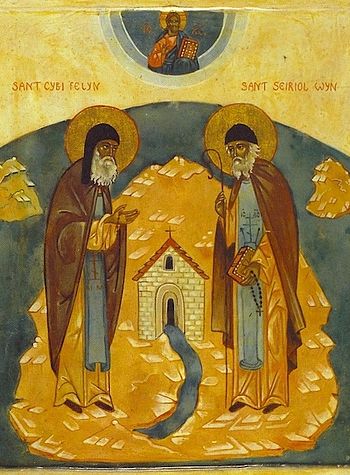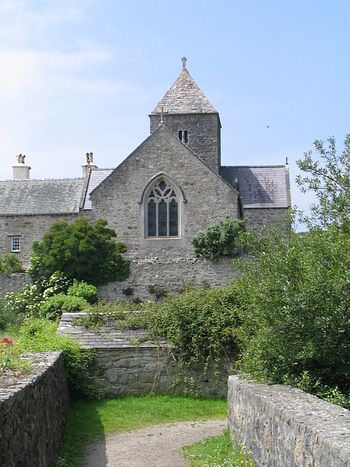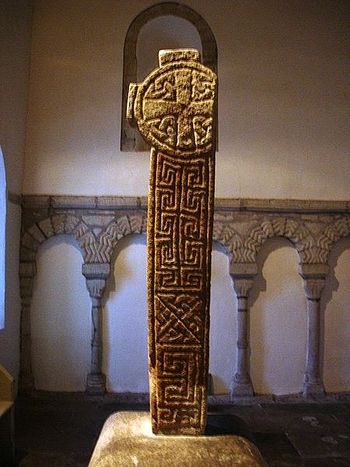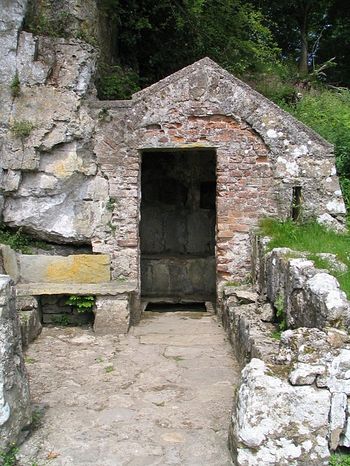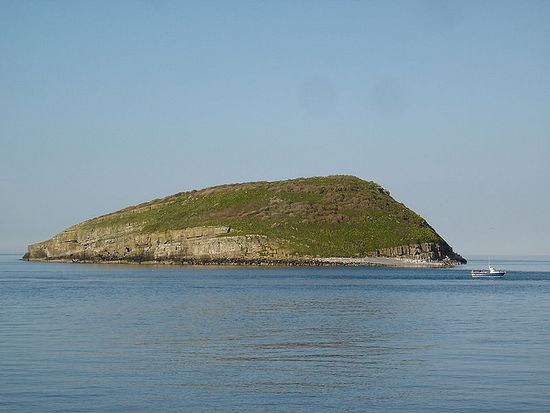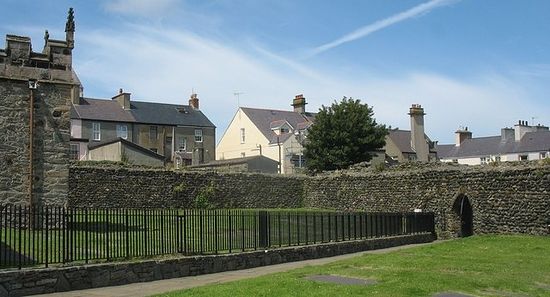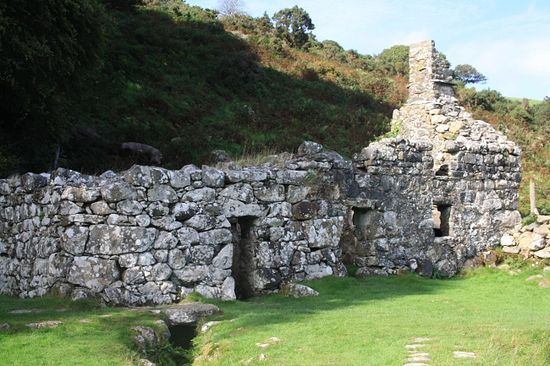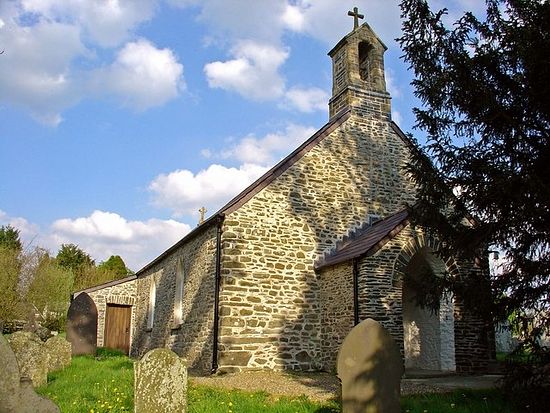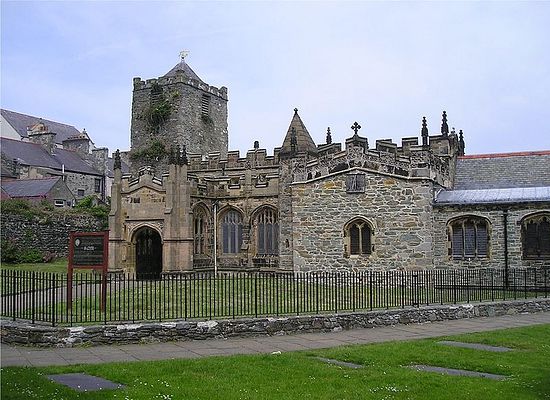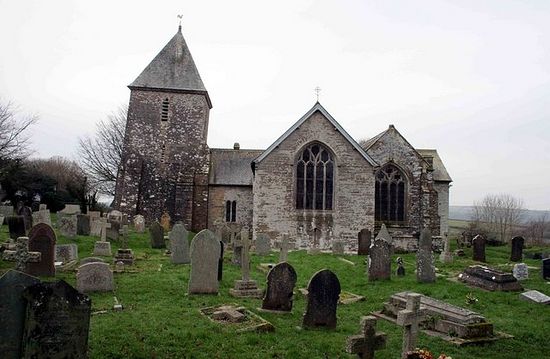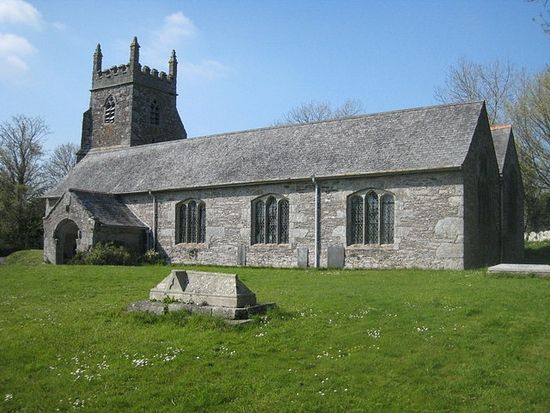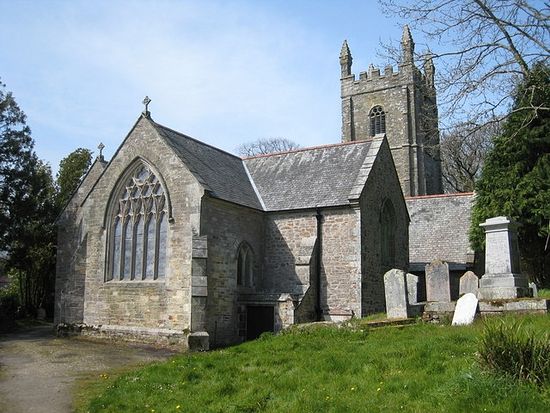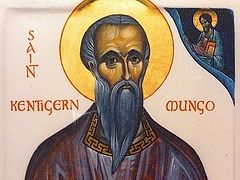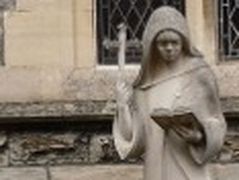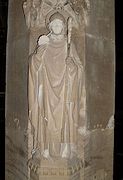Anglesey, or the Isle of Anglesey (the Welsh name—Ynys Mon), is an island (and a county) off the northwest coast of Wales, which is separated from it by the Menai Straits. The first Christian hermits appeared here in the fifth century. Orthodox Christianity flourished here for several centuries till the ninth century Viking raids, and many holy men and women lived and prayed here; this is evidenced by numerous surviving early churches, monastic ruins, holy wells, ancient crosses and hermits’ cells on the island.
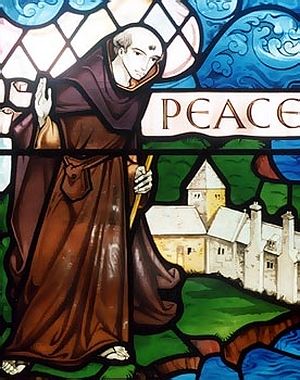 Saint Seiriol (a stained glass image)
Saint Seiriol (a stained glass image)
St. Seiriol, a Welsh hermit and son of a king, lived in the sixth century. Researchers suppose that he may have been born in 494. The saint for a long time lived as a hermit on Anglesey, where his little “beehive” cell and holy well still exist. According to tradition, he was a close friend of another Welsh ascetic, St. Cybi, and the saintly friends used to walk round the island together in silent prayer. There are extant medieval stories relating miracles, performed by the men of God Seiriol and Cybi, who lived in east and west Anglesey respectively. Both of them are venerated as the patron-saints of Anglesey and it was said that “their prayers wholly protected the island.”
Seiriol’s disciples built a monastery near a place called Penmon on the south-eastern tip of Anglesey and Seiriol became its first abbot. Later Penmon was to become one of major insular monastic centers in Wales; it was dedicated to St. Seiriol and Orthodox ascetic life flourished here until the tenth century. The monastery had a wooden church. Unfortunately, the Vikings plundered the monastery in 971.
Notably, two tenth century Celtic crosses, erected at the monastery gates before the Vikings’ arrival, as well as the font dating to the same period, not only survived the pirates’ invasion but have been preserved to this day. In about 1123 the old wooden church at Penmon was rebuilt in stone, and in the following thirteenth century a large Augustinian Catholic abbey was founded here. Augustinians liked restoring ancient shrines, so they preserved here what could be preserved from the Celtic period.
That abbey was dissolved in 1538 during the Reformation, but many of its buildings, or their ruins, still more or less survive. The oldest part of the present church dates from 1140, and pilgrims can see the monks’ dormitory, the monastery refectory and the prior’s house here. The holy well of Penmon which was used by St. Seiriol and his monks as early as the sixth century for drinking water and for baptisms, still gives water here today. Today Penmon is a small village and there are reports of healing miracles from its water.
Like many saints in the Celtic lands, St. Seiriol may have travelled extensively by sea, founding chapels and building cells in hermitages. By the end of his life the saint retired to the tiny island of Ynys-Seiriol (‘Seiriol’s island’) just off Anglesey, where he lived as a hermit and built a small monastery. Later the isle was renamed Priestholm (‘priest’s island’), but the modern name is Puffin Island. St. Seiriol probably reposed on this island; it is now uninhabited but the early ruins of a once prosperous monastery, founded by Seiriol, probably as a dependency of Penmon, can still be seen here together with an ancient tower.
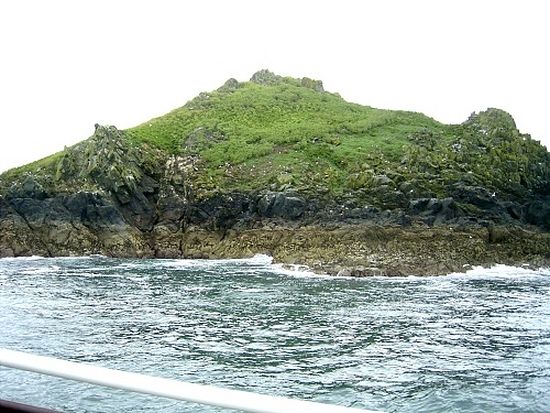 Monastic isle of Puffin (St. Seiriol's Isle)
Monastic isle of Puffin (St. Seiriol's Isle)
St. Seiriol is one of a great multitude of island saints who led a solitary life in tiny hermits’ cells on small isles off the coasts of Wales, Scotland and Ireland. Later monasteries appeared on the sites of their hermitages. There are many other surviving shrines throughout Anglesey, closely connected with numerous saints and hermits, who lived here in the golden age of “the Thebaid of Welsh Saints”. Another equally important island centre of Christianity in Wales was Bardsey. Both Penmon and Puffin Island (still unofficially known as Ynys Seiriol) have a church dedicated to St. Seiriol.
St. Cybi (also spelled Cuby; fifth-sixth centuries) is along with St. Seiriol one of the most venerated saints in Anglesey. During his life he was a pilgrim, for a short time a king, a priest, an abbot, a bishop, a hermit and a preacher. Unfortunately, very few details of his life survive and two late medieval lives of this saint are not reliable.
St. Cybi may have been a son of the Cornish king Solomon (Selyf). Most likely in his youth Cybi himself was king of Cornwall for some time. He was raised in the Christian faith and, according to legend, at a very young age made pilgrimages to the Holy Land and Rome. St. Cybi was ordained priest and with time was consecrated bishop. He travelled very extensively in his native Cornwall, preaching Christianity and building numerous churches. This saint is still particularly loved and venerated as patron-saint of the Cornish settlements Cuby, Tregony, Landulph, Duloe, and Kenwyn—churches in all of them have been dedicated to him from time immemorial.
Nevertheless, his main activities were undertaken in Wales, where he moved after some time. First Cybi settled in South Wales where he founded many churches. The most important of them were churches in Llangybi (“Church of Cybi”) and Llanddyfrwyr in Monmouthshire. He is the patron-saint of these places to this day. The saint may briefly have visited Ireland where he preached and built a church. He returned to Wales and moved to the very north, choosing what is now the small village of Llangybi on Llyn peninsula (south-west of Anglesey) as the centre of his ministry. The Llyn peninsula is washed by the Irish Sea and occupies part of the present-day county of Gwynedd. The local ruler gave the ancient Roman fort of Holyhead to the saint. This fort had been abandoned by the Romans late in the fourth century and subsequently it became known as Caer Gybi (“Cybi’s fortress”); it was located on the isle later called Ynys-Gybi (“Cybi’s island”); its second and common name is Holy Island. This islet was situated near the celebrated monastic island of Anglesey (now it is attached to the main island). On this islet St. Cybi founded his most important monastery and became its abbot.
St. Cybi was a close friend and co-faster of St. Seiriol, who founded the monastery on Anglesey. Cybi often retired to Anglesey for a quiet prayer, and it was said that both saints used to walk round the island in silence and contemplation. Interestingly, as Cybi walked over the island towards Seiriol, the sun shone in his face so that it soon became swarthy, and the local people nicknamed him “Cybi the tanned.” According to tradition, Cybi took part in the Council of Brefi in about 545, when St. David was elected Archbishop of the Welsh Church. St. Cybi reposed in the Lord between 550 and 555. He was buried inside a chapel near Holyhead monastery on Holy Island.
Pious Christians in both Wales and Cornwall honour the holy memory of St. Cybi to this day. In Llangybi village of Gwynedd, where he lived for some time, there is the holy well of St. Cybi, dating back to this time, and there is also a partly surviving “beehive” cell nearby, which belonged to him. Due to its curative properties this well is still visited by pilgrims and its water used for baptisms. From past times there exists a tradition that if an eel coils round the legs of a pilgrim, it means the healing will soon follow. Its water cures eye diseases, lameness, warts, scrofula, and rheumatism. According to an old popular belief (which is alive today), if a young lady throws her handkerchief into this well and it drifts to the south, it means that her young man has a serious intention of marrying her, but if it drifts to the north he will betray her trust. The well is situated in a beautiful area near the forest and the river.
Besides Llangybi on the Llyn peninsula there are two more settlements with the same name in Wales. One of them is a village in county Ceredigion. Local Christians pray at the Church of St. Cybi. This county also has a holy well dedicated to him. In Monmouthshire on the river Usk between the towns of Caerleon and Usk there is another village called Llangybi: the ancient local church is dedicated to the saint and it is believed that it was he who founded the first church here.
Many miracles are associated with St. Cybi. For example, when Cybi with his ten companions sailed from Cornwall, crossed the Bristol Channel and set foot on the Welsh shore, the missionaries were met by the local ruler in a very unfriendly manner—he simply wanted to drive them away. But as soon as the hostile king approached the monks, his horse suddenly fell dead and he himself was stricken with blindness as well as all his companions. Filled with remorse, the ruler fell on his knees before Cybi, asking his forgiveness and in an instant was healed together with his courtiers. The horse stood up safe and sound as well. In reward for the miracle the king gave lands to Cybi to found two churches: in Llangybi and possibly in the neighbouring village of Llandegveth. The St. Cybi’s Church in Llangybi is considered by many researches to be “one of the most interesting and remarkable churches situated in the Usk valley.” Its tower, chancel and nave go back to the thirteenth century, and it contains late medieval paintings.
However, the main centre for Cybi’s veneration is, beyond doubt, Holyhead—the chief town on Holy Island. Holyhead Monastery is unique, as it was built by Cybi within an ancient Roman fort. Truly it is a rare case when an ancient Christian monastery is erected inside an abandoned Roman fortress with three walls (the sea served as the fourth wall). There are only a few such examples in Europe. The ancient former abbey church, dedicated to St. Cybi, survives in Holyhead and is still visited by many pilgrims. There is a chapel near the church probably with the saint’s grave below it. This site is one of the rarest not only in Wales but in the whole of Europe. In addition to Holy Island-Ynys Gybi, there is also one more tiny isle with the same name, just off the Dyfed coast of Wales.
A number of churches in Cornwall are dedicated to St. Cybi, for example: the Church of Sts. Cybi and Leonard in Duloe, dating from the early middle ages, with a holy well; St. Cybi’s Church in the village of Cuby (named after him) whose south aisle contains a sixth century inscribed stone; the church in Kenwyn, a suburb of Truro, the county town of Cornwall, of which St. Cybi was formerly the patron-saint but whose patroness is now St. Keyne (feast: October 8/21).
Like many Celtic saints, St. Cybi was close to wild animals. Once while hunting, the king of Gwynedd was chasing a she-goat with his hounds. Escaping them, the goat ran up to St. Cybi’s hermitage hut. The enraged king ordered the hermit to give him the goat—otherwise he would be driven out of the kingdom. The saint answered humbly that to drive him away was not in the king’s power, but in God’s power alone, and suggested he devote this goat to the Lord. Ashamed, the king agreed, and it was decided that the land that the goat was to walk around would be allotted to found a monastery by St. Cybi. The goat walked round quite a large area and by the evening returned to its master’s dwelling. The king kept his promise and the monastery was built there.
Holy Fathers Seiriol and Cybi, pray to God for us!

